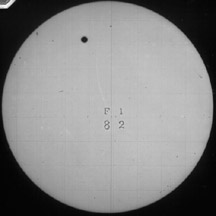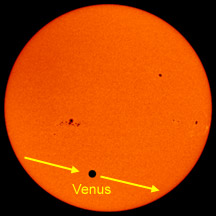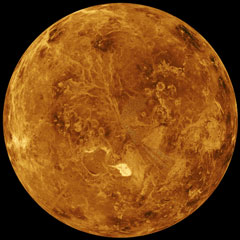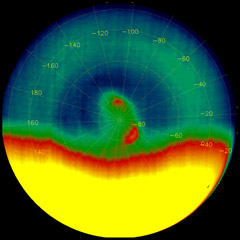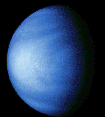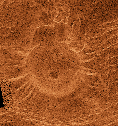Missions to Venus
| Mission | Country | Launch Date | Arrival Date | Type | Encounter Characteristics |
|---|---|---|---|---|---|
| Venera 1 | USSR | February 12, 1961 | ---- | Flyby | Now in solar orbit |
| Mariner 2 | USA | August 27, 1962 | December 14, 1962 | Flyby | Closest approach: 34,833 km |
| Zond 1 | USSR | April 2, 1964 | ---- | Probe | Now in solar orbit |
| Venera 2 | USSR | November 12, 1965 | ---- | Flyby | Communications failed just before arrival. Now in solar orbit. |
| Venera 3 | USSR | November 16, 1965 | ---- | Atmospheric Probe | Communications failed just before atmosphere entry. Crashed on Venus |
| Venera 4 | USSR | June 12, 1967 | October 18, 1967 | Atmospheric Probe | First probe to be placed directly in the atmosphere and to
return atmospheric data. It was crushed by the pressure on Venus before it reached the surface. |
| Mariner 5 | USA | June 14, 1967 | October 19, 1967 | Flyby | Closest approach: 3900 km |
| Venera 5 | USSR | January 5, 1969 | May 16, 1969 | Atmospheric Probe | Burn-up |
| Venera 6 | USSR | January 10, 1969 | May 17, 1969 | Atmospheric Probe | Returned data down to within 11 km of the surface before being crushed by the pressure. |
| Venera 7 | USSR | August 17, 1970 | December 15, 1970 | Lander | First successful landing of a spacecraft on another planet. Returned 23 minutes of data. |
| Venera 8 | USSR | March 27, 1972 | July 22, 1972 | Lander | Returned data for 50 minutes |
| Mariner 10 | USA | November 3, 1973 | February 5, 1974 | Flyby | Dual planet mission to Venus and Mercury. Closest approach: 5700 km Images of cloud top |
| Venera 9 | USSR | June 8, 1975 | October 22, 1975 | Orbiter | Periapsis: 1560 km Apoapsis: 112,200 km Period: 48 hours, 18 min Inclination: 34* 10' Photographed clouds and looked at the upper atmosphere. |
| Lander | Transmitted first black and white pictures of the planet's surface | ||||
| Venera 10 | USSR | June 14, 1975 | October 25, 1975 | Orbiter | Periapsis: 1620 km Apoapsis: 113,900 km Period: 49 hours, 23 min Inclination: 29* 30' Photographed clouds and looked at the upper atmosphere |
| Lander | Transmitted black and white photographs of the terrain. | ||||
| Pioneer Venus 1 (Pioneer 12) | USA | May 20, 1978 | December 4, 1978 | Orbiter | Periapsis: 200 km Apoapsis: 66,000 km Period: 24 hours Inclination: 29* 30' Operated until 1992 when contact was lost. First spacecraft to use radar in mapping the planet's surface. |
| Pioneer Venus 2 (Pioneer 13) | USA | August 8, 1978 | December 9, 1978 | Atmospheric Probe | 4 probes parachuted through the atmosphere. |
| Venera 11 | USSR | September 9, 1978 | December 25, 1978 | Flyby | Closest approach: 25,000 km |
| Lander | Returned data for 95 minutes. Imaging systems failed. |
||||
| Venera 12 | USSR | September 14, 1978 | December 21, 1978 | Flyby | Closest approach: 25,000 km |
| Lander | Returned data for 110 minutes. Electrical discharges were recorded. |
||||
| Venera 13 | USSR | October 30, 1981 | March 1, 1982 | Flyby | |
| Lander | First color panoramic views of the planet's surface. Conducted soil analysis. |
||||
| Venera 14 | USSR | November 4, 1981 | March 5, 1982 | Flyby | |
| Entry probe | Returned both black & white and color panoramic views of the
planet's surface. Conducted soil analysis. |
||||
| Venera 15 | USSR | June 2, 1983 | October 10, 1983 | Orbiter | Radar imaging |
| Venera 16 | USSR | June 7, 1983 | October 14, 1983 | Orbiter | Radar imaging |
| Vega 1 | USSR | December 15, 1984 | June 11, 1985 | Balloon/Lander | Vega 1 dropped off a Venera style lander and a balloon. The lander's soil experiment failed. The balloon floated for about 48 hours. Now in solar orbit. |
| Vega 2 | USSR | December 21, 1984 | June 15, 1985 | Balloon/Lander | Vega 2 dropped off a Venera style lander and a balloon. The lander conducted soil experiments. The balloon floated for about 48 hours. Now in solar orbit. |
| Galileo | USA & Europe | October 18, 1989 | February 10, 1990 | Flyby | Images and near-infrared data on clouds. Used Venus to pick up speed on its way to Jupiter. |
| Magellan | USA | May 4, 1989 | August 10, 1990 | Orbiter | Mapped Venus using synthetic aperture radar. The imaging system produced images at 300 meters resolution. |







